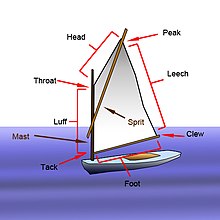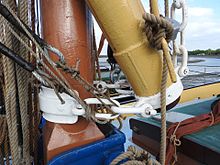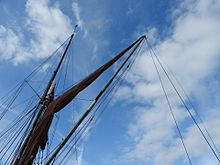Spritsail

Edges: Luff Head Leech Foot
Corners: Tack Throat Peak Clew

The spritsail is a four-sided,

Historically, spritsails were the first European
The rig
The luff of the sail is bound to the mast, but unlike the
Barges


The spritsail was best known from its use in the

The spritsail rig was normally used without a
In a commercial vessel, the rig has the advantage of allowing a high stack of deck cargo and freeing the cargo hatch of obstructions when loading and unloading. The entire sail can be quickly brailed to the mast. The overriding advantage is safety in open water. Barges are unballasted and, if overpressed, will heel excessively and must be pulled to wind. The sheet will be eased and the aft end of a boom could drag in the water making the rudder ineffective and a capsize inevitable. The sheet of loose footed boomless barge is just released and control is regained.[8] The boom does not project outboard so that the vessel can pass through a narrow gap between moored vessels. Loose footed sails suffer from sail twist which reduces their aerodynamic efficiency when sailing off the wind, which usually is not a commercial issue. It can be an advantage in light air. The vangs control the head of the sail which can be set so as to make use of the air above the wind-shadow of moored ships, warehouses and so on.[9]

This fine control of the sail without need for the crew to leave the deck, is achieved by brailing up. Rather than lowering the mainsail, it is gathered up against its own luff and head by means of lines called brails. This technique is an effective way of stowing the mainsail and gives fine control over the power obtained from the sail. In narrow channels, and in the lee of tall buildings the mailsail and mizzen are brailed and the bowsprit topped up, and she sails on topsail and foresail alone.[10] A gaff rig was far more suitable for heavy weather and long sea passages, but when a gaff rigged vessel drops the mainsail, the topsail cannot be used. The gaff, attached to the mainsail, is required aloft to set the topsail.[11]
However, the sprit rig means that the sail is stowed aloft and unreachable from the deck. It also means that the sail cannot easily be covered when it is stowed, and thus protected from the elements. But in any case, the crews of working vessels did not trouble with such dainty ways. In keeping with the general philosophy of working boats, all sails would therefore be traditionally treated with red oxide and other substances.[12]

The problem of the inaccessibility of gear was met in the Thames barge by stepping the mast in a tabernacle and using a windlass on the foredeck to strike the whole lot, mast, sprit, sails and rigging. The crew could sail under a low bridge such as at Aylesford or Rochester without losing steerage way. The windlass is below the tack of the foresail and the tackle at the foot of the forestay. In striking the gear, the foresail tack tackle had to be cast off. With the bridge cleared, the skipper and an extra man (the huffler) used the windlass to raise the mast.[13]
Dinghies

Modern use of the spritsail has also become more common through its use in the Optimist (dinghy) - this uses a boomed spritsail - in the case of which the sprit is tensioned by a snotter arrangement. This much simpler implementation sees the sprit anchored higher on the mast than on barges.
Leg of mutton spritsail
This is a sprit rig that uses a triangular sail, the luff is bent to the mast, and the one spar, the sprit-boom attaches to the clew of the sail. The fore end of the boom is tensioned (pulled tight to the mast) by use of a snotter chord. It is a precursor of the wishbone rig first popularised by windsurfers. On a Bolger 59 (square foot) rig, there is a 14'3" luff, 13'7" leech and 9'0" foot. [14]
Local boats

The spritsail is also commonly used in a fore-and-aft rig (along with a staysail) on local traditional wooden boats of the west coast of Norway, most notably the faering variant of the Oselvar.[15] Traditionally, up until the second half of the 1800s, these boats used to be rigged with a square rig.[16]
Square rigged ships
In an inconvenient piece of nautical ambiguity, the term "spritsail" also refers to
See also
References
- ^ Underhill, Harold (1938). "Glossary". Sailing Ship Rigs and Rigging (Second, 1958 ed.). Glasgow: Brown, Son and Ferguson. p. 114.
- ^ ISBN 978-0-8018-5130-8, pp. 243–245
- ISBN 0-670-81416-4.
- ^ March 1948, p. 224.
- ^ March 1948, p. 234.
- ^ March 1948, pp. 225, 234.
- ^ "Duckworks - Boomed Vs Boomless". www.duckworksmagazine.com. Retrieved 12 May 2017.
- ^ Lillistone, Ross. "Duckworks - Boomed Vs Boomless". www.duckworksmagazine.com. Retrieved 11 May 2018.
- ^ March, Edgar (1948). Spritsail Barges of Thames and Medway. London: Percival Marshall. p. 7.
- ^ March 1948, p. 24.
- ISBN 0953818012.
- ^ March 1948, p. 116.
- ^ March 1948, p. 129.
- ^ Routh, David (Shorty). "My favorite sail, the Leg-o-Mutton Sprit". www.duckworksmagazine.com. Archived from the original on 2 November 2019. Retrieved 5 May 2017.
- ^ no:Fil:Oselver.jpg
- ^ Google Translate
- ^ Anderson, R. C. (1927). "Peface". The Rigging of Ships in the Days of the Spritsail Topmast 1600-1720 (First, 1927 ed.). Portland, Maine: The Southworth Press. p. vii.
External links
- Web article Archived 2019-11-02 at the Wayback Machine about triangular 'Leg-o-Mutton' sprit sail rig.
- Video of sailing the Oselvar A spritsail-rigged Norwegian traditional wooden boat.
- "The amazing Spritsail, a forgotten jewel". christinedemerchant.com. Retrieved 23 April 2018.
